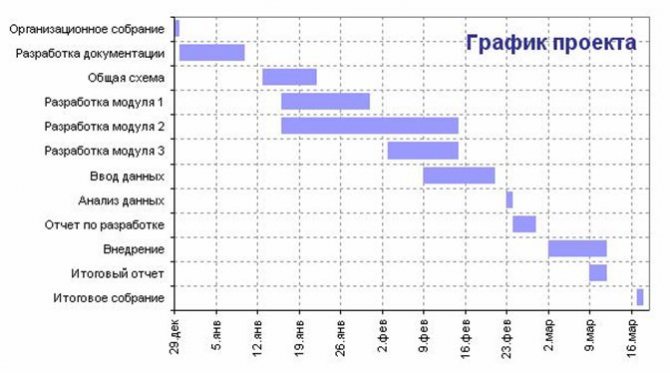Basic criteria for scheduling work
In modern personnel records management, work scheduling has been simplified by the introduction of electronic forms. The work schedule corresponds to the form provided by the 1C: Salary and Personnel program. This form is unique. It is designed taking into account the individual characteristics of any enterprise. The HR officer’s task is to correctly draw up the internals of the proposed form, namely the content, which consists of distributing personnel according to the work schedule. The internal content is designed taking into account the convenience of work not only for employees, but also for accounting calculations. Working with the 1C program reduces the time spent by the clerk on drawing up work schedules.
The program takes into account the features of different lengths of working weeks:
- 40 hour;
- 36 hour;
- 30 hour;
- 24 hour and others.
The preparation of the work schedule is based on:
- on the operating mode (the operating time of the enterprise;
- on labor legislation.
The operating mode of an organization (institution, enterprise) is the fixed time of production. The worker (specialist) spends time preparing the work area and performs certain procedures at the end of the working day. Starting work requires a minimum 10-minute deviation from the opening of the organization.
For example. The kindergarten operates on a 12-hour schedule - from 7.00 to 19.00. Kindergarten teachers should start their day at 6:50 a.m. and end at 7:10 p.m. The working hours of teachers do not duplicate the work of the preschool organization. Compliance with legal requirements is strictly observed: i.e. The time required for the teacher to perform work duties (8 hours, 7.2 hours) is strictly observed. An individual employee is obliged to fulfill the hourly rate established for his workplace.
It is better to plan rest breaks by studying the sanitary standards and rules established in production. Lunch rest varies in different organizations, mainly within time limits - 12.00-15.00.
The schedule reflects how the institution operates on established holidays and on weekends (shops, factories with non-stop production, etc.). A well-constructed schedule will eliminate cases of shortcomings, overwork, underfunding, or, conversely, exceeding the estimated wage calculations. An error-free schedule will help optimize the work process.
Types of remote work
In the new edition of Art. 312.1 of the Labor Code of the Russian Federation distinguishes between remote, temporary remote and combined remote work.
Remote (remote) work. The definition of remote work largely duplicates the current provisions of the Labor Code of the Russian Federation. So, remote (remote) work is the performance of a labor function defined by an employment contract outside the location of the employer, its branch, representative office, other separate (structural) unit (including those located in another area), outside a stationary workplace, territory or facility, directly or indirectly under the control of the employer, subject to the use of public ITS, including the Internet, to perform this job function and to carry out interaction between the employer and employee on issues related to its implementation.
Temporary remote (remote) work. This is a work mode that provides for the temporary performance of the labor function of an employee working on the basis of an employment contract, outside a stationary workplace under the control of the employer.
The grounds for establishing a regime of temporary remote (remote) work may be an agreement of the parties, production necessity, a natural or man-made disaster, an industrial accident, an industrial accident, a fire, a flood, an earthquake, an epidemic, an epizootic and any exceptional cases that threaten life. or normal living conditions of the entire population or part of it.
During the performance of a labor function remotely, workers in temporary remote (remote) work mode are subject to the norms of Chapter. 49.1 of the Labor Code of the Russian Federation on the specifics of regulating the labor of remote workers, including in terms of labor protection.
Wages for temporary remote (remote) work are paid in full, while maintaining the amount of work stipulated by the employment contract.
Combined remote (remote) work. This is a work mode that includes work at a stationary workplace and remote (remote) work.
The combined operating mode is established in the manner prescribed by Chapter. 49.1 of the Labor Code of the Russian Federation for establishing temporary remote (remote) work. At the same time, the features of the organization and labor protection, working hours and rest time, established by this chapter, do not apply to the period of work performed at a stationary workplace.
Remote workers are considered to be persons who have entered into an employment contract for remote work. Remote workers are subject to labor legislation and other acts containing labor law norms, taking into account the specifics established by this chapter (Article 312.1.1 of the Labor Code of the Russian Federation).
Kinds
There are three types of work schedules: shift, rotating, weekly. All schedules have both advantages and disadvantages, but their type is necessary to meet the specifics of the work of a particular institution.
The shift schedule is used mainly by organizations with a 24-hour work system. In addition, in those organizations (the majority of them), the schedule assumes that employees work in succession. Sometimes charts calculate the period of joint work of two or more specialties at one workplace; this is mainly found in education, culture and healthcare. Shift work allows for non-stop production. The definition of the shift work schedule is given in the Labor Code of the Russian Federation, Article 103.
The law identifies 2 cases of using a shift schedule:
- Non-stop (continuity) of the production process. The working hours exceed the daily production norm - 7.2 hours (women), 8 hours - men.
- Efficiency of the equipment used (stopping the operation of units, or constant switching on/off leads to production losses).
Shift work schedules are compiled according to the forms offered by the electronic version of the program. Shifts, their number, time period are determined, and then the data is entered into the program. Most often, the shift schedule is made for a month in order to change employees in shifts within a month (1,2, night). If shifts are arranged correctly, there will be no overtime for one employee and shortcomings for another.
Shift work schedules can be changed or left unchanged. It all depends on the capabilities and characteristics of production.
A sliding work schedule is used in institutions where the traveling nature of work (business trips) is used: employees of railway institutions. In their schedules, the start time of the working day (train crews) and the end of the work shift (freight transportation), for road transport (long-distance trips) and other similar services are unknown. The personnel officer records upon receipt of information that the employee has begun his duties and their completion. From the fact of finishing work, the calculation of time for rest begins, then the start time of work (trip, departure on a flight) is determined again, i.e. Truly, the schedule slides according to the calendar and is individual for each individual employee. The electronic version of the sliding schedule allows you to track the hours worked by each member of the work unit. The weekends here are also sliding, only approximate dates are set, and the fact is revealed during the labor process.
The weekly schedule is used when employees work out the standard hours without being directly at their workplace every day, but only in the sum of the numerical values of the time worked for the week. The departure to work is selected by a specialist and agreed with the head of the department, workshop, etc. individually. This mode is also called flexible working mode. It is considered the most common abroad. There are many benefits to the weekly regimen: increased work efficiency, a decrease in the level of disciplinary violations, and improved psychological health of employees.
Article 102 of the Labor Code of the Russian Federation also defines the weekly operating hours. The weekly schedule is used in the following cases:
- Working outside the office (working place at home, coming to the organization to receive a task or to coordinate assignments, handing over completed work), so-called homeworkers.
- Real estate companies where employees are forced to work according to a schedule that is set not by the employer, but by the client. These are, for example, real estate specialists: agents, managers, couriers.
- Accountant. Nowadays it is becoming fashionable to hire one accountant. Small companies, private entrepreneurs, and individual entrepreneurs prefer not to maintain an accounting staff, but to carry out accounting through a separately hired specialist. In this case, the accountant processes documents at home, or in some room, but outside of production. It makes no sense to set him any kind of work schedule other than a weekly one, since he can complete the entire amount of work at a time convenient for him.
The wages of these employees do not depend on the time worked, so the employees themselves control its implementation. The norm for them corresponds to the norm of ordinary workers, but the regime is different. It is difficult to record the work time of a given employee in a specific schedule, so the form is filled out, indicating the approximate standard of hours, rather than tracking the actual value.
The schedule must include time to restore physical strength. Rest time usually divides the working day into two parts of approximately equal time. Most often, this is one lunch break. The actual length of time used for rest and food is not included in working time. According to Art. 108 of the Labor Code of the Russian Federation, breaks provided to an employee during a working day (shift) can be no more than 2 hours and less than 30 minutes. There are organizations where they choose short technological breaks, they last no more than 15 minutes. If you have been tasked with drawing up a work schedule, then you must first decide on the type of schedule that is most appropriate for your organization (enterprise).

Tabular work schedule
Types of working hours
The Labor Code distinguishes the following working hours:
- regular (single shift)
- irregular
- flexible
- removable
- rotational
- fragmented working day
Regular schedule

, with a lunch break from 13.00 to 14.00. The employee works at a strictly designated time: from Monday to Friday, from nine in the morning until six in the evening, with a lunch break from 13.00 to 14.00. There are no options here - every day, every month and all year the employee works in the same mode. This regime is ensured due to the absence of a technological and production need for the employer to perform its tasks within a normal time frame, and, as a result, there is no need to keep total records of the time of its personnel, since the normal working week for such an employee will not exceed 40 hours, which corresponds to legal requirements.
Irregular
Irregular working hours are a special work regime, according to which individual employees may, by order of the employer, if necessary, be occasionally involved in the performance of their labor functions outside the established working hours. The list of positions of employees with irregular working hours is established by a collective agreement, agreements or local regulations adopted taking into account the opinion of the representative body of employees.
Flexible schedule
A flexible working time regime is a form of labor organization in which individual workers or teams of structural divisions of an organization are allowed, but within certain limits, self-regulation of the beginning, end and general duration of the working day. In this case, it is required to fully work out the total number of working hours established by law during the accepted accounting period - working day, week, month and others (Article 102 of the Labor Code of the Russian Federation).

Shift work
Shift work is a work schedule according to which the working hours of an enterprise employee may vary on different days. The introduction of such a labor regime is advisable when the production process is continuous and requires constant management and control by workers.
A shift work schedule is established in institutions where the production process exceeds the standard permissible working day, as well as in order to maximize the efficient use of machinery and equipment, increase the volume of products produced, goods (services provided). They work in 2, 3, 4 shifts.
The need to introduce just such an organization of work arises when an institution, by its nature or social necessity, must work continuously, or with short breaks. In this case, workers are divided into certain groups (teams), which consistently perform work to avoid interruptions or stops in the production (technological) process.
Shift schedule
The rotation method is a special form of carrying out the labor process outside the place of permanent residence of workers, when their daily return to their place of permanent residence cannot be ensured. The rotation method is used when the place of work is significantly removed from the location of the employer in order to reduce the time required for construction, repair or reconstruction of industrial, social and other facilities in uninhabited, remote areas or areas with special natural conditions.
Fragmented
This regime is regulated by Art. 105 of the Labor Code of the Russian Federation, and, as a rule, is applicable when performing work with unequal intensity throughout the entire work shift. For example, a fragmented operating mode is used by organizations providing transport services to the population, communication services and trade. The division of working time is carried out by the employer in accordance with the internal rules of the organization, drawn up taking into account the opinion of the trade union body. Russian labor legislation does not stipulate how many parts a working day can be divided into, but, as practice shows, a shift is divided into 2 or more parts, and the unpaid break between them can be no more than 2 hours.
Types of charts
There are quite a large number of types of schedules, but most enterprises have now switched to the same unified forms of the electronic version of personnel programs. They allow you not to waste time on creating your own forms, entering formulas and other tasks that programmers perform. The document specialist selects the type of schedule.
Types of charts:
- tabular;
- program;
- diagrammatic.

Diagrammatic work schedule
Registration of labor relations
The specifics of concluding and changing the terms of an employment contract on remote work are established in Art. 312.2 Labor Code of the Russian Federation.
An employment contract for remote work and agreements to change the terms of the employment contract for remote work determined by the parties can be concluded by exchanging electronic documents.
The location of the employer is indicated as the place of concluding an employment contract on remote work, agreements on changing the terms of the employment contract on remote work determined by the parties.
Upon a written request from a remote worker, the employer, no later than five working days from the date of receipt of such an application, is obliged to send the remote worker a copy of the employment contract on paper.
When concluding an employment contract on remote work through the exchange of electronic documents, the documents provided for in Art. 65 of the Labor Code of the Russian Federation (passport, work book, SNILS, etc.), can be presented to the employer by a person applying for remote work in the form of an electronic document. At the request of the employer, this person is obliged to provide him with notarized copies of these documents on paper.
Familiarization of the person concluding an employment contract for remote work with the documents provided for in Part 3 of Art. 68 of the Labor Code of the Russian Federation (internal labor regulations, collective agreement, local acts directly related to the employee’s work activity) can be carried out by exchanging electronic documents.
When concluding an employment contract for remote work by exchanging electronic documents by a person concluding an employment contract for the first time, this person receives a document confirming registration in the individual (personalized) accounting system, including in the form of an electronic document, independently.
An employment contract on remote work may establish an additional condition regarding the duty of a remote worker to use equipment, software and hardware, information security tools and other means provided or recommended by the employer when performing his job functions under an employment contract on remote work.
An employee has the right to use his personal equipment, software and hardware, and information security tools during remote work. Collective agreements, local regulations adopted taking into account the opinion of the elected body of the primary trade union organization, and labor contracts on remote work may provide for the procedure for compensation of expenses associated with the employee’s use of personal equipment, software and hardware, and information security tools.
An employment contract for remote work may not indicate the workplace condition provided for in an employment contract in accordance with Art. 57 Labor Code of the Russian Federation.
The temporary remote (remote) work mode is introduced on the basis of (Article 312.6 of the Labor Code of the Russian Federation):
- an employment contract concluded between an employer and an employee;
- additional agreement to the employment contract, if the grounds for establishing a temporary remote (remote) work regime arose after the conclusion of the employment contract.
These documents establish the procedure for temporary remote (remote) work, providing for:
- schedule of temporary remote (remote) work - the number and frequency of providing working days and working hours to an employee in the mode of temporary remote (remote) work;
- methods of exchanging information between workers about production tasks and their implementation;
- the ability to use resources (equipment, payment of expenses for the use of communication technologies) of the organization at the place where the employee performs temporary remote (remote) work.
A simplified procedure for introducing a regime of temporary remote (remote) work is allowed in the event of a natural or man-made disaster, industrial accident, industrial accident, fire, flood, earthquake, epidemic, epizootic and in any exceptional cases that threaten life or normal living conditions the entire population or part of it.
The simplified procedure provides for the publication of a local regulatory act establishing lists of workers transferred with their consent to temporary remote (remote) work, as well as the procedure for organizing a temporary remote (remote) work regime, including:
- the period for which the employee is transferred to temporary remote (remote) work;
- work schedule at a stationary workplace and outside it, the possibility of its subsequent adjustment (if necessary);
- working hours, including the time during which the employee must be available to communicate with the employer within the working hours established by the internal labor regulations (if the specified regime differs from those established by the internal labor regulations);
- other questions.
Under the simplified procedure, the terms of the employment contract do not change, an additional agreement to the employment contract is not concluded, while the methods of interaction between the employer and employees, issues of reimbursement (if necessary) related to the performance of temporary remote work (for electricity, used software (including anti-virus protection) ) and other expenses) are established in local regulations adopted taking into account the opinion of the elected body of the primary trade union organization.
The local regulatory act on the introduction of a temporary remote (remote) work regime in a simplified manner, as well as the changes made to it, must be familiarized to the employee in accordance with the established method of interaction.
As a matter of priority, temporary remote work in a simplified manner in the event of a catastrophe, industrial accident, fire, flood, earthquake, epidemic and in any exceptional cases that threaten the life or normal living conditions of the entire population or part of it is transferred (if there are appropriate technical and organizational capabilities):
- pregnant women;
- workers (guardians, trustees, foster parents) with children under the age of 14, disabled people;
- old age pensioners;
- workers caring for disabled people or long-term ill family members who need care for health reasons;
- other categories of employees provided for by the collective agreement, local regulations, or employment contracts.
The schedule is being drawn up in stages.
The accounting period is selected
It is necessary to set the working time recording period - month, quarter, year. The selected time period directly depends on the nature of production, its specifics, and the characteristics of labor.
Example. College employees must complete an hourly workload from September to May. We distribute the hours of workload for the teacher according to the accounting period. In this case, summer is excluded and included in the vacation period. If the earned vacation time is not enough (for example, vacation is 44 days, the teacher is not involved - 90 days), the teacher is offered rest at his own expense, additional workload or other options. The accounting period in this case is the academic year (not the financial year).
The time fund for servicing a specific workplace is calculated
For each workplace, the fund of serviced time is calculated. Loading the workplace. The load for any type of schedule is calculated in hours and minutes.
For example. The workplace of a turner-milling operator functions according to the action of the machine. The machine works for 3 hours non-stop. After three hours, the unit takes 1.5 hours to cool down. Therefore, the operating time of the machine is 15 hours per day. The last rest for the machine is given for 3 hours. During this time, shift changes can be arranged in the work schedule. Men work on these machines - their working hours are 8 hours, so with the right schedule, you can easily assign two staff units to one machine.
If the employee’s place is occupied for 24 hours (power grid manager). This norm is calculated for the accounting period (year) and is evenly distributed over the working time of individual employees.
The hourly rate is determined
The duration of work of individual specialties has a different meaning from that of the entire staff. The schedule assigns a value to each employee if his standard working time differs from the standard of work of others.
Example. Various specialists work in an educational institution. The length of their working week is different, for example, a teacher is required to work 36 hours a week, a music director - 24 hours, a teacher - speech therapist - 20 hours. The maximum operating time per month (production rate) is different for them, it should be reflected in the schedule. The load should not be allowed to exceed the norm, as it will require additional financial investments.
Counting the number of workers
The number of employees per workplace and the total number of staff are calculated. This number of employees must serve the workplace and fulfill the plan. This results in a quantitative staffing structure – staff. Standard indicator of staffing units of an enterprise.
Example. The duty dispatcher of the power grid organizes round-the-clock duty at the control panel. The accounting period of its work is calculated for the financial year. The total service time for the dispatcher's workplace is 8760 hours (365 calendar days × 24 hours). We calculate the number required to service this workplace; it is approximately 4.8 people. In practice, an employer can hire five people, or maybe four, distributing part-time wages among employees.
Mixed work mode: difficulties and risks
Let's consider what difficulties and risks arise when using a mixed mode of operation, as well as how to eliminate or reduce them. The material uses the conventional name “mixed work mode”, by which the author understands the nature of the work (the method of performing the labor function), in which the parties determine the order of distribution in time (during the working week) of the place where the employee’s labor function is performed, both on the premises of the employer and outside them, as well as the conditions for performing work outside the employer’s premises.
Lack of legal regulation of labor features in mixed work modes
The lack of clear rules can lead to misunderstandings both between the parties to the employment contract and with the inspection (control) authorities.
In this case, we recommend that this nature of the labor relationship be described as fully as possible in the LPA and (or) employment contract. And it is mandatory to familiarize the employee with it against his signature (clauses 2 - 3, part 1, article 54, clauses 10, 15, part 1, article 55 of the Labor Code).
Occupational safety issues
When performing work outside the employer's premises, as a rule, a workplace is not created, but the employee has a stationary workplace, where labor safety measures are carried out in full.
We believe that the same rules should be applied to work outside the employer’s premises as to the work of remote workers. We recommend that these issues be spelled out in the LPA and the employment contract.
Control of working hours and ensuring production, technological, performance and labor discipline (clause 2 - 3, part 1, article 55, article 133 of the Labor Code)
Recommendations:
1. The employer can control the work of this category of workers mainly through information and communication technologies. In particular, control of an employee when performing work outside the employer’s premises can be carried out via video communication. To do this, just install the desired program. In the employment contract, it is advisable to stipulate as a separate clause the employee’s obligation to go on a video call at a set time.
2. The employer can give the employee equipment (laptop) in which a special working time tracking program will be installed. It will allow you to track what the employee did remotely, what sites he visited, and how much time he spent at work. For example, if an employee spent most of his time resting or visiting sites that pose a threat of infection to both the PC and the local network, we believe that the employer has the right to dismiss this employee for failure to perform duties.
In general, we recommend that the section on the employee’s main responsibilities include, in particular, the following requirements (responsibilities):
— use only work applications, remote access and a time tracking program during work (working time);
- get in touch exactly on time;
- periodically visit the employer’s office;
- transmit work reports.
Recording facts of violations of production, technological, performance and labor discipline
We can distinguish two types of violations (production-technological, performance and labor discipline) that employees commit (may commit) when performing work outside the employer’s premises:
- shortcomings in work, for example, when an employee avoids work or produces poor results (i.e. violations in the performance of a job function);
— violations of executive and labor discipline, for example, when an employee does not communicate or is intoxicated during working hours.
For the first violations, difficulties in bringing to disciplinary liability should not arise if the employee was first correctly assigned the task. That is, provided that the deadline and format for providing the result were specified in the LPA and (or) the employment contract. If an employee does not complete such a task, fails to meet the deadline, or does it poorly, then no separate recording is required. It is enough that the immediate supervisor writes a memo addressed to management and sets out all the circumstances in it.
Violations of labor discipline are more difficult, because There are problems with confirming that, for example, the employee did not actually work for half a day or that he conducted a video conference while intoxicated.
In particular, the state of alcohol intoxication must be confirmed by a health care organization or, by all indications, be attested by others (witnesses and an authorized person of the employer). In the case of remote work, the employer has no opportunity to either examine the employee for intoxication or record the most obvious sign of intoxication - the smell of alcohol. The employee can explain the remaining signs of intoxication (incoherent speech, redness of the face, etc.), for example, by the fact that he had an attack of hypertension.
The same is true with absence from the workplace: when performing work outside the employer’s premises, the employee does not have a workplace as such.
Thus, in relation to remote workers, there is actually only one option: to hold them accountable for the consequences of performing or failing to perform a job function, and not for the fact itself, which cannot be established (absenteeism, being intoxicated during working hours, etc.) .
Failure by an employee to perform work outside the employer’s premises may be expressed, for example, in failure to submit reports on the work done within the deadlines established by the employment agreement (contract), failure to fulfill the scope of work established by the employment agreement, etc.
Unlike remote workers, with a mixed work schedule, workers are also required to be at stationary workplaces, which makes it easier, to a certain extent, to document violations of labor discipline on the part of the employee.
The risks of employee abuse of alcohol or avoidance of work can be minimized by assigning specific and measurable tasks to the employee within a short time frame.
Disclosure of commercial or confidential information
Employees are obliged, in particular, to comply with the trade secret regime established by the employer, not to disclose information constituting a trade secret of the employer, and (or) information constituting a trade secret of third parties to which the employer has gained access, and also not to use information constituting a trade secret, for purposes not related to the performance of labor (official) duties (clause 10, part 1, article 53 of the Labor Code, paragraph 2, article 16 of the Law on Trade Secrets, subclause 14.10, clause 14 of the Model Internal Labor Regulations, subclause 8.10 clause 8 of the sample form of the employment contract, subclause 2.10 clause 2 of the sample form of the contract between the employer and the employee).
When performing work outside the employer's premises, the risks of disclosing commercial or confidential information increase, even if the employee is conscientious. Especially if the employee uses his own equipment at work without using protective programs.
In such a situation, we recommend that you spell out in more detail the issues of ensuring the trade secret regime, in particular the employee’s responsibilities, in the LPA and the employment contract, provide him with the necessary equipment, and instruct him on how to work with information that has limited distribution, especially when performing work outside the employer’s premises.
Read this material in ilex >>* *follow the link you will be taken to the paid content of the ilex service










